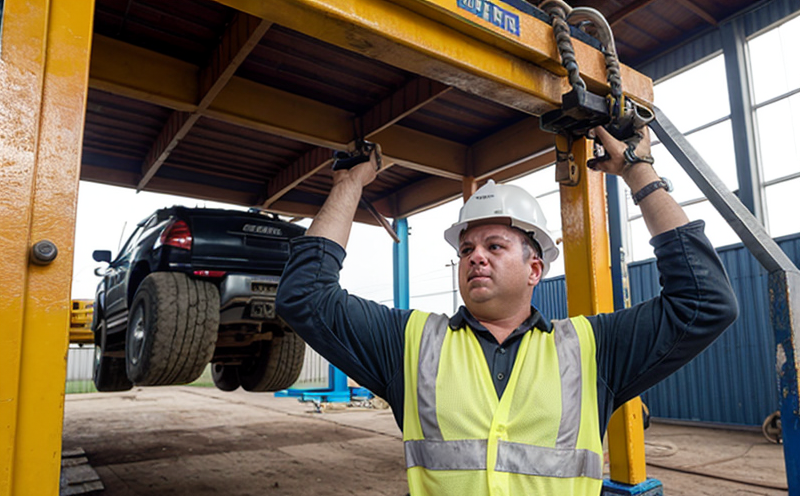Grab lifting device inspection
The inspection of grab lifting devices is a critical aspect within the broader sector of lifting equipment and crane safety. Grab lifting devices are designed to securely grip and lift materials, ensuring safe operation in industrial settings such as ports, warehouses, and construction sites. Ensuring these devices meet regulatory standards not only protects workers but also ensures efficient operations.
Grab lifting devices typically consist of a hook or jaws that engage with the load. These devices are subjected to rigorous inspection protocols to ensure they operate reliably under various conditions. The inspection process includes visual checks, mechanical stress tests, and wear analysis to identify any potential issues before they lead to accidents or failures.
The sector context for grab lifting device inspections is dominated by safety regulations aimed at minimizing risks in heavy industrial operations. Compliance with these standards ensures that the equipment not only functions as intended but also adheres to international best practices, which are critical for maintaining high-quality manufacturing and operational standards.
Inspection criteria vary depending on the specific type of grab lifting device and its application. For instance, grabs used in maritime environments must withstand harsh weather conditions and corrosive saltwater. Similarly, those used in construction may need to handle heavy loads repeatedly without failure. The inspection process is designed to identify any signs of wear, corrosion, or structural damage that could compromise safety.
Regulatory compliance for grab lifting devices involves adherence to standards such as ISO 9431-2:2008 and EN 15751:2006. These standards provide detailed guidelines on the inspection procedures, acceptance criteria, and maintenance schedules necessary for ensuring safe operations.
During an inspection, it is essential to follow a structured approach that includes initial visual assessments followed by more in-depth mechanical evaluations. This ensures that any issues are identified early, preventing potential accidents or equipment failures. The inspection should also involve a review of the device's history, including previous inspections and maintenance records.
The process typically begins with a thorough examination of the grab’s components, focusing on the integrity of the jaws or hooks. This includes checking for any visible signs of wear, corrosion, or damage that could affect its performance. The mechanical aspects of the inspection involve testing the device's lifting capacity and ensuring it can perform within specified limits under various conditions.
For grabs used in maritime environments, additional checks are necessary to ensure they can withstand exposure to saltwater and extreme temperatures. This includes assessing the corrosion resistance and structural integrity of the components. Similarly, for construction applications, inspections focus on durability and load-bearing capabilities, ensuring the device can handle repeated use without degradation.
The inspection process is not just about identifying issues; it also involves understanding the environmental factors that could impact the performance of grab lifting devices. For instance, grabs used in cold climates may require special attention to ensure they do not freeze or become brittle. In contrast, those used in hot environments need checks for overheating and potential thermal expansion.
The results of inspections are documented meticulously and form part of the device's maintenance history. This documentation is crucial for tracking the condition of the grab over time and identifying any patterns that could indicate a need for preventive maintenance or replacement. Regular inspection schedules, often aligned with regulatory requirements, ensure ongoing compliance and safety.
By adhering to these stringent inspection protocols, industries can maintain high standards of operational safety and efficiency. This not only protects workers but also ensures that the equipment remains reliable and effective in its intended applications.
Applied Standards
| Standard | Description |
|---|---|
| ISO 9431-2:2008 | This standard provides guidelines for the inspection and testing of crane hoisting equipment, including grab lifting devices. |
| EN 15751:2006 | An European standard that specifies requirements for the design, construction, and inspection of grabs used in cranes. |
Benefits
- Enhances operational safety by identifying potential hazards early.
- Prevents accidents and equipment failures through regular maintenance.
- Ensures compliance with international standards, thereby protecting the organization's reputation.
- Reduces downtime due to unexpected failures or repairs.
- Improves overall efficiency by ensuring reliable performance of lifting equipment.
Customer Impact and Satisfaction
- Safety: Customers can rest assured that their operations are conducted in a safe environment, reducing the risk of accidents.
- Trust: Compliance with international standards builds trust with stakeholders, including employees and clients.
- Efficiency: Reliable equipment ensures continuous operation without disruptions due to maintenance or repairs.





